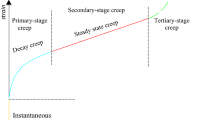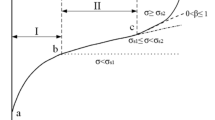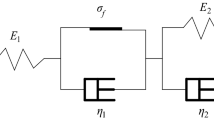Abstract
To study visco-elastic–plastic creep constitutive relation of tunnels in soft schist, a triaxial creep mechanical test was conducted at first. Next, by studying linear and nonlinear visco-elastic–plastic creep constitutive relation of soft schist, the nonlinear visco-elastic–plastic creep constitutive model is established. The constitutive model can be used to describe the whole process of initial, steady and accelerated creep stages. By comparing the nonlinear visco-elastic–plastic creep constitutive model to a linear constitutive model, the characteristics of engineering applicability of different constitutive models are obtained. Finally, creep parameters, change law and influence law of moisture contents on the constitutive model are separately discussed, which provides practical and theoretical bases for analyzing long-term stability of surrounding rocks of tunnels in soft schist.














Similar content being viewed by others
References
Brotóns V, Ivorra S, Tomás R, et al (2014) Proposal of a new rock creep model. In: Alejano R, Perucho Á, Olalla C, Jiménez R (eds) Rock engineering and rock mechanics: structures in and on rock masses. Taylor & Francis Group, London
Dai HL, Wang X, Xie GX et al (2004) Theoretical model and solution for the rheological problem of anchor-grouting a soft rock tunnel. Int J Press Vessels Pip 81(9):739–748
Liu Q, Pan Y, Liu J et al (2016) Comparison and discussion on fragmentation behavior of soft rock in multi-indentation tests by a single TBM disc cutter. Tunn Undergr Space Technol 57:151–161
Lo CM, Feng ZY (2014) Deformation characteristics of slate slopes associated with morphology and creep. Eng Geol 178:132–154
Lopez M, Kahn LF, Kurtis KE (2004) Creep and shrinkage of high-performance lightweight concrete. ACI Mater J 101(5):391–399
Martin LB, Rutqvist J, Birkholzer JT, et al (2015) Three-dimensional modeling of a heater test to investigate crushed salt reconsolidation and rock salt creep for the underground disposal of high-level nuclear waste. 13th ISRM international congress of rock mechanics. International Society for Rock Mechanics
Mishra B, Verma P (2015) Uniaxial and triaxial single and multistage creep tests on coal-measure shale rocks. Int J Coal Geol 137:55–65
Shahid S, Nath SK, Roy J (2000) Groundwater potential modelling in a soft rock area using a GIS. Int J Remote Sens 21(9):1919–1924
Tonnellier A, Helmstetter A, Malet JP et al (2013) Seismic monitoring of soft-rock landslides: the Super-Sauze and Valoria case studies. Geophys J Int 193(3):1515–1536
Wang G, Zhang Y, Xiong X et al (2012) Experiment of creep characteristics of carbonaceous slate of deep-buried tunnel with large deformation. J Highw Transp Res Dev 9:017
Wenling C, Fasuo Z, Hujun G (2011) Study of creep parameters of mica-quartzose schist during triaxial creep test. Chin J Rock Mech Eng 30(S1):2810–2816
Yang X, Pang J, Liu D et al (2013) Deformation mechanism of roadways in deep soft rock at Hegang Xing’an Coal Mine. Int J Min Sci Technol 23(2):307–312
Yuan HP, Cao P, Xu WZ (2014) Visco-elastop-lastic constitutive relationship of rock and modified Burgers creep model. Chin J Geotech Eng 28(6):796–799
Zhang L, Liu Y, Yang Q (2014) A creep model with damage based on internal variable theory and its fundamental properties. Mech Mater 78:44–55
Author information
Authors and Affiliations
Corresponding author
Rights and permissions
About this article
Cite this article
Zuo, Y.Y., Han, L., Hu, H. et al. Visco-elastic–Plastic Creep Constitutive Relation of Tunnels in Soft Schist. Geotech Geol Eng 36, 389–400 (2018). https://doi.org/10.1007/s10706-017-0333-6
Received:
Accepted:
Published:
Issue Date:
DOI: https://doi.org/10.1007/s10706-017-0333-6




